Heraklion Markets: What to See and Find in Central Market 🛒

The Heraklion Markets, known as the Central Market, are a thriving and busy centre in the middle of Heraklion, Crete. “Heraklion Markets” refers to the city’s several marketplaces and retail locations, each offering a distinct experience. The central market complex is an essential element of the cultural and gastronomic character of the city.
1866 Street in Heraklion is a busy avenue essential to the Heraklion Markets. It’s a well-known retail area in Heraklion, with many businesses, booths and sellers. The street is a major thoroughfare connecting tourists to different central market portions.
Visitors to the Heraklion Markets anticipate a compelling mix of sights and noises. The central market area is a vibrant environment where local traders proudly showcase their wares. Fresh products include vivid fruits and vegetables, fragrant herbs and various Cretan delicacies. The market has stands selling spices, cheeses, olives, other typical Cretan fare and fresh fruits and vegetables. The markets are a place for shopping and for experiencing the lively local culture, where the warm welcome of the people and the fragrances of fresh cuisine create an immersive experience.
Treasure seekers and antiquing aficionados enjoy perusing the wares in the Flea Market, located apart from the main market area. Vintage apparel, one-of-a-kind souvenirs and hidden jewels await discovery here. The Flea Market lends a special touch to the Heraklion Markets, making it a popular destination for food and those looking for unique gifts.
The Heraklion Markets, the city’s central marketplace, is a fascinating place to spend time with tourists. It’s a place where the essence of Cretan culture and business merge, with its broad selection of fresh vegetables, local specialities and the appeal of the Flea Market. The central market and its neighbouring 1866 Street are crucial stops for tourists wishing to immerse themselves in the heart of Heraklion’s dynamic environment.
What is Heraklion Markets?
Heraklion Markets refers to the several markets and marketplaces in and around Heraklion, the Greek island of Crete’s major city. These markets are thriving centres of trade and cultural interaction, providing both residents and visitors with a diverse variety of products and experiences. The Heraklion Municipal Market, often known as the “Agora”, is the most renowned of these marketplaces. It is a lively indoor market where sellers offer fresh fruit, meat, seafood and other locally derived items. Visitors immerse themselves in the sights, sounds and fragrances of the Mediterranean as they meander through the labyrinthine passageways of the old market.
Heraklion has more than just the Municipal Market. There are flea markets and gift shops where tourists find traditional Cretan crafts, clothes, jewellery and other items. These markets are places to purchase and learn about local culture and food. Heraklion Market provides a unique combination of heritage and modernity, where centuries-old rituals coexist with cutting-edge shopping experiences. It offers a thrilling and genuine experience for everyone, regardless of whether the goal is to discover the gastronomic wonders of Crete or to purchase a piece of its rich cultural legacy.
What is the 1866 Street in Heraklion?
The 1866 Street in Heraklion, commonly known as “1866 Street Heraklion” or simply “Heraklion Shopping Street”, is a lively and historic road in the centre of Heraklion, Greece’s capital city. 1866 Street is well-known for containing the Heraklion Central Market, which acts as a bustling commercial area. The market is a covered area where individual merchants specialise in different products, including fruits, vegetables, olives, local cheeses, apparel, shoes, leather goods, herbs, spices, meat and other things. It’s a location where history meets modernity, with family-owned companies proudly continuing to operate for generations.
The market, located on 1866 Street, pays attention to an important historical event by remembering the year of a notable Cretan insurrection. The street itself spans from the Meidani to Kornarou Square, putting it near the famed Lions’ Square and the Morosini Fountain. Go early in the day when residents swarm to do their shopping before the heat of the noon sun sets to enjoy the market at its liveliest. Visitors discover cafés and tavernas among the bright and busy bustle of the marketplace, where they savour local flavours and soak in the vivid ambience.
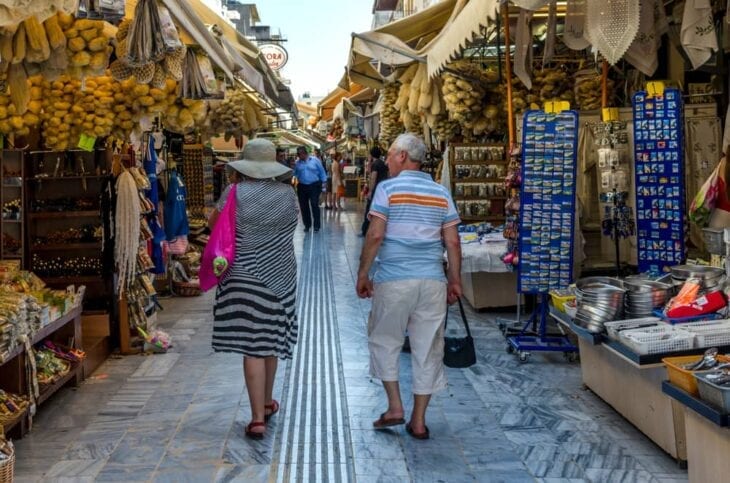
Find stores along the old street that specialise in local gifts and souvenirs, given how well-known Heraklion is as a tourist attraction. These include packaged dried herbs and hand-milled olive oil soaps, enabling tourists to take home a piece of Crete’s distinctive history. The 1866 Street in Heraklion, with its Central Market and unique commercial scene, provides a beautiful combination of heritage and modern business, making it a must-visit location for tourists touring the picturesque Cretan city.
What can you See in Heraklion Markets?
You can see a broad selection of products and gastronomic pleasures in The Heraklion Markets. Fresh fruits, vegetables, olives, cheeses, cured meats like “apaki” and “siglino”, sausages and even artisanal delicacies like “almira”, which are savoury biscuits flavoured with fresh herbs, spinach or olives, are available in Heraklion’s Central Market. Local bakeries produce wonderful Cretan barley rusks called “paximadia”. There are possibilities to buy extra virgin olive oil, a mainstay of Mediterranean cuisine. The Heraklion Fish Market, which is part of the Central Market, offers a fantastic selection of fresh seafood, including scorpion fish and whitebait, sea bream, octopus, prawns, squid and even sea urchins.
The Heraklion Markets have set hours of operation, which generally begin in the morning. Go early in the morning to see the market at its busiest. Mornings are perfect for exploring and shopping for fresh produce and culinary delights since local sellers seek to serve customers before the noon heat sets in.
The Heraklion Markets usually shut in the late afternoon or early evening, depending on the season. Closing hours vary based on the market or seller, but it’s typically a good idea to arrange the visit earlier to ensure enough time to explore and make purchases. “Laiki”, or weekly market, is another unique thing to do in Heraklion. Purchase directly from farmers, cheesemakers, winemakers, beekeepers and other producers, providing a greater connection to the region’s culture and cuisine.
What to Buy at the Laiki weekly markets?
The laiki is not just for locals, although you will not see nearly as many tourists there. True, you will see shoppers buying tremendous quantities of produce. But it’s fine to get just a kilo or two of fruits or vegetables. The selection is astonishing. Not to miss in summer are the fresh figs – nowhere in Greece are the figs as sweet and fragrant of those in Crete and that is saying a lot.
Melons, too, are superb. And Crete also produces most of Greece’s avocados. Tomatoes are obviously also the stars of summer and into the fall. Another item unique to Crete and some other islands are “atzouria”. These look like cucumbers but are fuzzy on the outside and have a very pale green skin. They are crisper and more fragrant than regular cucumbers. Another specialty are zucchini blossoms, which the Cretans stuff with rice and fresh herbs.
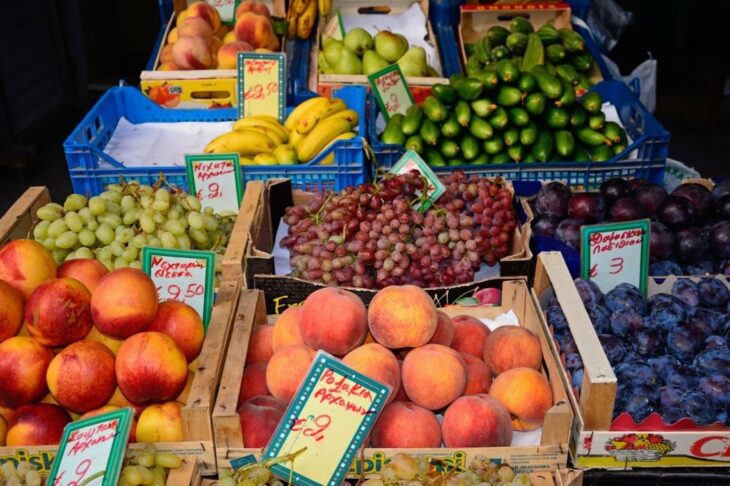
Even if you do not plan on doing a lot of cooking during your stay, you can still get a lot out of your trip to the laiki. Besides stocking up on seasonal fruits (at a very low price), you can even find some special items that you can take home. Try the tiny “tsakistes” – small green olives that are slightly crushed and bathed in fresh lemon juice or the small black olives cured in salt. You can get an entire small wheel of artisanal graviera. And the honey of Crete is some of Greece’s very finest. The bees feast on the local wild thyme. It’s like the sweet summer breeze of Crete in a jar.
What can you Find in the Flea Market?
You can find an intriguing assortment of used and vintage items, collectables, antiquities and unique artefacts in the Flea Market in Heraklion, which is commonly referred to as “shopping Heraklion”. The market is a treasure trove for individuals who appreciate digging for hidden jewels and one-of-a-kind products. Vintage clothes, jewellery, accessories, antique books, vinyl recordings, retro furniture, artwork, handicrafts and different oddities from the past are all available from Flea Market vendors.
Visiting the Flea Market is like stepping into a time capsule where visitors learn about the region’s history and culture via the things on exhibit. The Heraklion Flea Market is a great location to find unusual and nostalgic artefacts that tell tales of days gone by, whether a collector, a history buff or just searching for something special to take home as a memento. It’s a must-see for everyone who likes antique shopping and discovering the lovely and quirky side of Heraklion’s retail sector.
How Far is the Heraklion Airport from the Market?
The distance from Heraklion Airport (Nikos Kazantzakis International Airport) to the central market in Heraklion, Greece, is very short, making it easy for travellers arriving at the airport to visit the city’s busy market. The airport is around 4.5 kilometres (about 2.79 miles) east of Heraklion’s city centre, through Leof Nearchou, where the Central Market, Flea Market and many retail districts are found.
Travellers have various alternatives for getting to the market from the airport. The most usual and easiest option is to take a cab or utilise a ride-sharing service, which brings visitors to the market in approximately 15-20 minutes, depending on traffic. The airport is connected to the city centre by a public bus service, which offers a more economical means of transportation for visitors wishing to tour the markets. The bus trip usually lasts 20-30 minutes.
The closeness of Heraklion Airport to the downtown market area guarantees that visitors rapidly transition from their arrival to the centre of the city, where they immerse themselves in the dynamic retail and cultural attractions that Heraklion has to offer.
Are there Hotels Near Heraklion Market?
Yes, there are hotels near Heraklion Market. Heraklion is a famous tourist destination in Crete, Greece and it has a variety of lodging alternatives to meet a variety of budgets and interests. Travellers quickly visit the bustling market district of the city and its surroundings due to the abundance of hotels nearby, which range in price from luxurious to affordable.
There are various benefits to staying at a hotel near Heraklion Market. It provides simple access to the market, allowing visitors to investigate the vibrant kiosks loaded with fresh produce, local goods and mementoes. Being close to the market allows visitors to immerse themselves in local culture, sample traditional Cretan food and enjoy the city’s colourful environment.
There are hotels around Heraklion Market, including three standouts. The GDM Megaron Hotel stands out for its luxury rooms, first-rate services and breathtaking views of Heraklion’s ancient harbour, making it a perfect option for anyone looking for comfort and hospitality in the city’s centre. Dimargio Luxury Hotel & Spa provides an environment of refinement and leisure, with beautiful accommodations, a world-class spa and delicious food, making it the ideal escape after a day of touring the lively market. Sartori Concept Hotel, situated in the centre of Heraklion, stands apart by offering an intimate and personalised experience, with beautifully decorated rooms and painstaking attention to detail, all while being conveniently positioned near the popular Heraklion Market. These hotels appeal to those who want to be close to the lively market area while still being comfortable.
The features and pricing ranges of the Hotels in Heraklion vary, allowing travellers to choose lodgings that match their interests and budget. Some hotels have views of the market or the neighbouring Venetian Harbour, creating a one-of-a-kind and gorgeous backdrop for the stay.
Where to Eat in Heraklion Market?
The Heraklion Market, known as the Heraklion Municipal Market, is a lively and busy location where visitors discover and eat a variety of delectable cuisine selections. The old food market is located on 1866 Street in the middle of Heraklion, Crete and is readily accessible.
The cuisine available at Heraklion Market is varied and delicious. Fresh products such as fruits, vegetables and herbs are abundant, highlighting the region’s solid agricultural capabilities. There are local artisanal goods, cheeses, olives and traditional Cretan delights, enabling visitors to savour the island’s flavours.
Three notable eateries in Heraklion provide the essence of Cretan food. Thigaterra is a culinary gem that exemplifies the best of Crete with its commitment to fresh, locally derived ingredients and time-honored cooking techniques. Meanwhile, Ligo Krasi Ligo Thalassa provides a seafood frenzy with spectacular views of the Heraklion harbour, dishing up fresh catches coupled seamlessly with local wines and traditional Cretan dishes. Peskesi is a popular destination for both residents and visitors looking for genuine flavours, featuring traditional Cretan cuisine made from seasonal, locally sourced ingredients. These Restaurants in Heraklion offer a delectable culinary voyage through the flavours and traditions of Crete.
Where to Find Variety of Fishes in Heraklion Market?
The Heraklion Fish Market is a section of the Central Market in Heraklion, Crete and is well-known for its distinct character and offers. The location of the Central Market has a unique personality and serves as a gathering place for eager and driven fishmongers committed to selling their seafood at the peak of freshness.
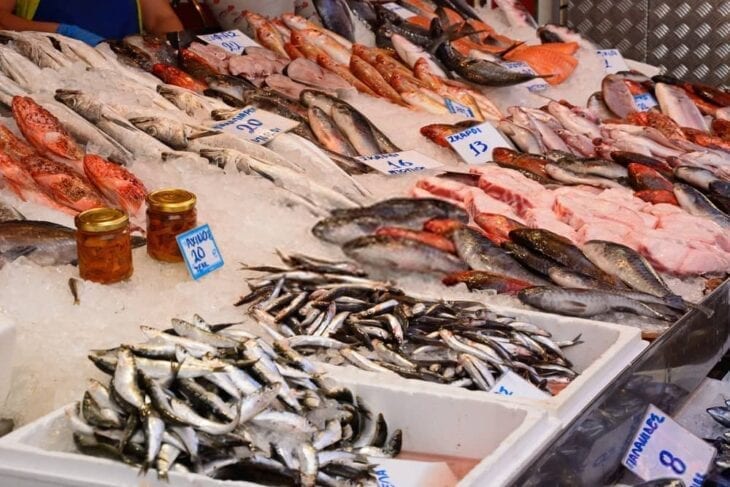
The variety of fish offered at the Heraklion Fish Market is broad and stunning. Dramatic scorpion fish are ideal for making flavorful stews and are among the most popular options. There are small “atherina”, often known as whitebait, that are fried whole and eaten head and all. Another popular market catch is fat sea bream, which is highly sought after for being grilled to perfection. Octopus, prawns, squid and even sea urchins, which the locals prize as delicacies, are among the various seafood riches to discover.
There are several traditional and modern methods to prepare the beloved fish. Sea bream is grilled to bring out its natural flavours, whilst scorpion fish is used to produce rich and fragrant soups. Atherina is usually deep-fried because it is small. It makes a crispy and tasty meal. The variety of fish available at the Heraklion Fish Market offers many culinary options.
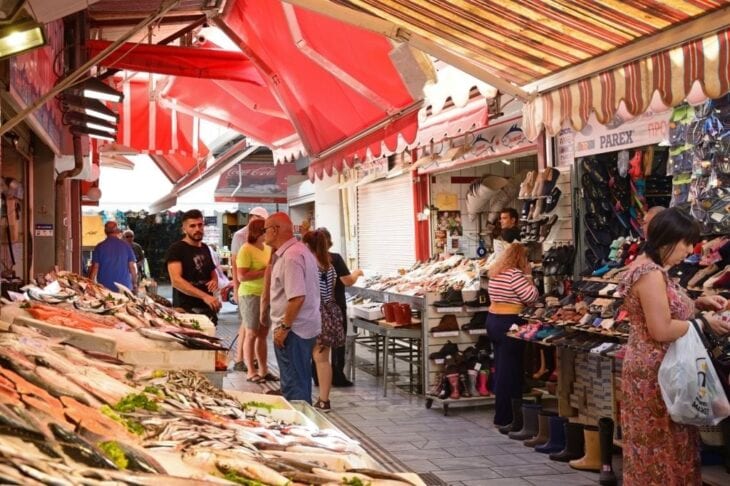
The Central Market in Heraklion has vendors selling a range of fresh goods in addition to seafood, including fruits, vegetables, cheeses, olives and traditional Cretan fare. It’s a dynamic and genuine marketplace to discover the region’s rich flavours and culinary traditions while feasting on the finest fish available at the Heraklion Fish Market.
Can I Rent a Car in Heraklion?
Yes, you can rent a car in Heraklion. Heraklion, being one of Crete’s main transit hubs, provides a convenient chance to hire a vehicle and explore the island at one’s leisure. Heraklion Port is exceptionally well-connected, acting as a hub for ferries from Piraeus and other Greek islands and a starting point for exploring Crete’s road network.
Heraklion car rentals typically include 24-hour delivery and collection, an all-risk insurance policy with no excess, a wide range of rental cars from luxury sedans to compact cars, free cancellation up to 48 hours before arrival and the option to add an extra driver or baby seat. Respectable automobile rental businesses often provide openness with no hidden or additional expenses.
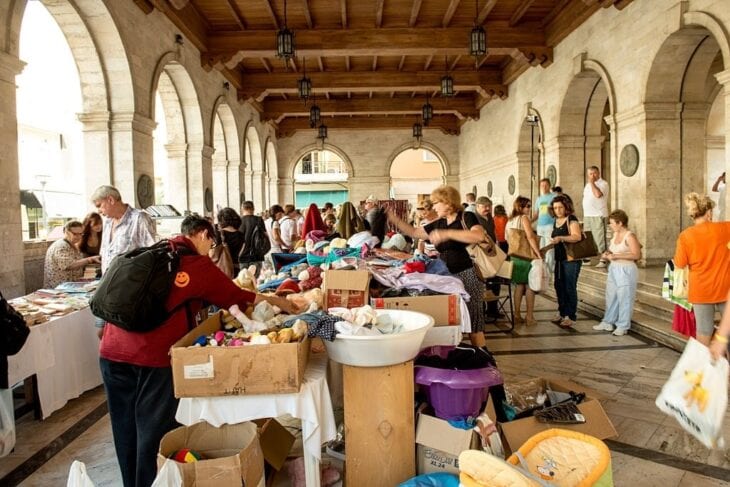
Heraklion Port’s central position and access to Crete’s major roads make it a perfect starting place for visiting the island’s various landscapes, ancient attractions and beautiful villages. Adapt the trip according to interests by hiring a vehicle in Heraklion, whether seeing historical sites like the Phaistos Minoan Palace or just taking in the beautiful scenery along Crete’s coasts. Rental companies such as Rental Center Crete provide dependable services, allowing guests to embark on exciting trips around the culturally rich and interesting Greek island.
What are Other Popular Activities in Heraklion?
Other popular activities in Heraklion are listed below.
- Discover the Palace of Knossos: The ancient Palace of Knossos, a remarkable archaeological site west of Heraklion, offers insights into Minoan culture. Explore the maze-like ruins and learn about the fabled Minotaur and King Minos. Knossos Palace is one of the most amazing places to visit in Heraklion.
- Visit Charming Villages: Explore the traditional villages of Crete by travelling to Archanes, Agios Nikolaos and Anogia. Experience local customs, sample handcrafted goods and marvel at the magnificent scenery.
- Relax on Amoudara Beach: Amoudara Beach is a popular area for sunbathing and swimming and is just a short drive from Heraklion. It has a variety of water sports, seaside tavernas and a lively environment.
- Visit the Heraklion Archaeological Museum: It displays a remarkable collection of Minoan artefacts from the ancient Palace of Knossos. It is a must-see for history buffs and anyone interested in the island’s extensive archaeological legacy.
- Taste Cretan Cuisine: Savour Cretan flavours while eating at authentic Cretan tavernas. Try dakos (tomato-feta rusk), lamb with stamnagathi (wild greens) and the famed Cretan salad with local olive oil and cheese.
- Buy souvenirs: Look throughout the city’s stores and boutiques, in addition to the Heraklion Market, for one-of-a-kind trinkets, including regional crafts, handcrafted pottery and traditional Cretan fabrics.
- Hike the Samaria Gorge: Hikers looking for a hard day journey through breathtaking natural beauty, including a small canyon and unspoiled landscapes, must plan a day excursion to Samaria Gorge National Park.
- Discover Historical Landmarks: Heraklion is home to several historical sites, including the Venetian Fortress of Koules, the Morosini Fountain and the Loggia. Stroll across the city, taking in its rich history and architecture.
- Attend Festivals and Events: Check the local calendar for upcoming festivals and cultural events. Music festivals, religious festivities and traditional dance performances are examples of such events.
- Wine Tasting: Crete is well-known for its wine production and the area is home to several wineries. Take a wine tour and try some of the best wines on the island, including rare varietals like Vidiano and Malvasia.
Heraklion offers an abundance of attractions and activities that appeal to a wide variety of interests. The city offers a fascinating peek into the past, from experiencing ancient history at Knossos Palace to immersing oneself in the rich cultural legacy at the Heraklion Archaeological Museum. Heraklion is a well-rounded tourist destination in addition to its historical riches due to its thriving culinary scene, gorgeous beaches and stunning surroundings. Heraklion offers it all, whether someone is interested in history, food or just relaxing in the sun. Read up on things to do in Heraklion before making the most of one’s time in the fascinating metropolis.
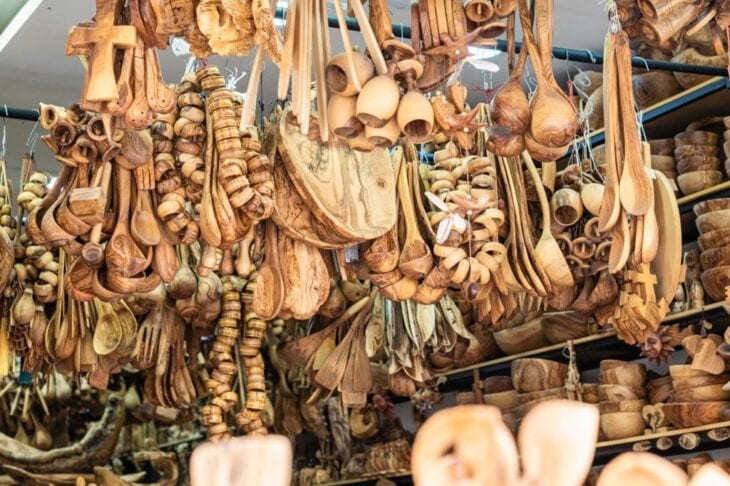
Which Direction is the Heraklion Museum Located?
The Heraklion Archaeological Museum is located on Heraklion Market Street (1866). The distance between them is around 1.9 km. A path includes Leof Ikarou, Stefanou Xanthoudidou and other westward streets going to the museum from the market. Travel time by car is around 5 minutes; however, travel times vary based on traffic conditions. The Archaeological Museum in Heraklion is located in Heraklion at the junction of Stefanou Xanthoudidou and Chatzidaki 1, making it readily accessible from the market area. The museum is a must-see for everyone interested in learning about Crete’s rich history and archaeological riches.
How is the Cretan Road for Compact Cars in Heraklion Crete?
The state of Cretan Road for Compact Cars in Heraklion Crete varies depending on the route and location. Major roads and highways in and around Heraklion are generally well-kept and suited for compact cars. The city’s road system is usually in high condition, providing tourists with a pleasant driving experience. Driving carefully is advised since visitors have the chance to come across smaller roads or surfaces with sporadic potholes in certain rural or less populated regions.
Drive carefully and adapt to local driving norms since specific routes are twisting or steep, necessitating cautious navigation. Driving in Crete is a pleasurable way to discover the island’s different landscapes, from coastal roads with breathtaking sea views to alpine routes leading to lovely towns. The quality of signage varies, so having a GPS or map aids with navigation. Exploring Heraklion and the rest of Crete by compact car is a rewarding and enjoyable experience with proper planning and a spirit of adventure.
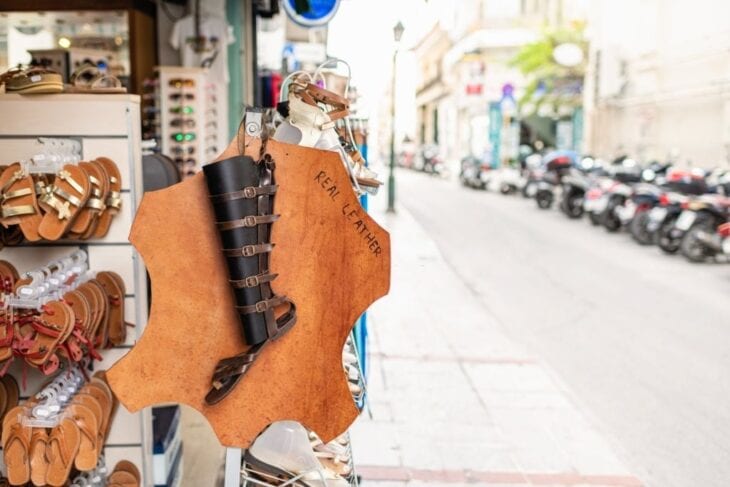
When is the Best Time to Visit Heraklion Markets?
The best time to visit the markets in Heraklion, Crete, depends on one’s preferences and desired type of experience. There are several things to keep in mind. The Heraklion Markets are best explored in the spring, from April through June. The weather is pleasant and the city comes alive with vibrant flowers and delicious vegetables. The weather is excellent for wandering the market and learning about the local culture.
Summer, which is from July to August, is the height of the tourist season in Crete, including in Heraklion. Markets are often less crowded than during the summer months, providing consumers with a more relaxing shopping experience. Tolerating the heat rewards visitors with a lively environment and a broad selection of items, including fresh produce from nearby farms and unique artwork crafted by local artisans.
Early autumn, especially September and October, is a beautiful time to visit the Heraklion Markets. The weather stays pleasant, but the people begin to diminish. Enjoy the freshest goods as well as a more comfortable shopping experience.
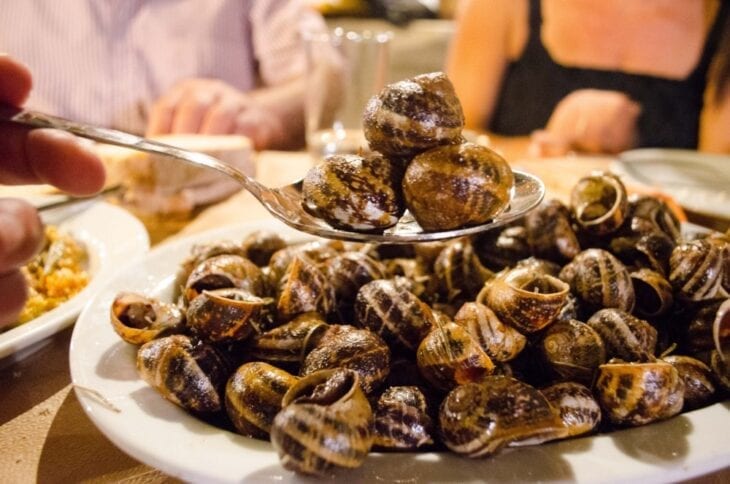
Winter, which is from December to March, is the least-visited time of year in Heraklion. Fewer people are in the markets, although some merchants have shortened their hours. Locate one-of-a-kind items and savour the regional delicacies, but be prepared to endure the cold if looking for a more sedate experience.The ideal time to visit the Heraklion Markets in Crete depends on the preferences for the weather and people. Spring and early autumn are often considered the best seasons for a well-rounded experience. Remember that the “Best Time to Visit Crete” relies on the overall trip objectives since Crete has much to offer all year.
What other markets are there in Crete and Chania?
The famous Agora Market, commonly called the Municipal Market of Chania, sits at the centre of Chania’s markets. The magnificent neoclassical structure that houses the bustling market complex doubles as a nexus for locals and visitors. Chania Markets has various individual stalls, stores, and vendors selling various products, from handicrafts and souvenirs to fresh vegetables and regional specialities.
The Agora Market, often known as the municipal market of Chania, is a shining example of what shopping at the Chania Markets is like . The Agora Market’s architectural influences from the early 20th century are seen in its historical relevance. Visitors are welcomed inside by an alluring fusion of sights, sounds, and smells. The market arrangement encourages exploration, with areas devoted to various goods. The colourful fruits, vegetables, and fragrant herbs that line the shelves represent Crete’s abundant agricultural production. Displays of beef, cheese, and regional dairy products that emphasise the island’s culinary diversity and displays of fresh fish draw attention.
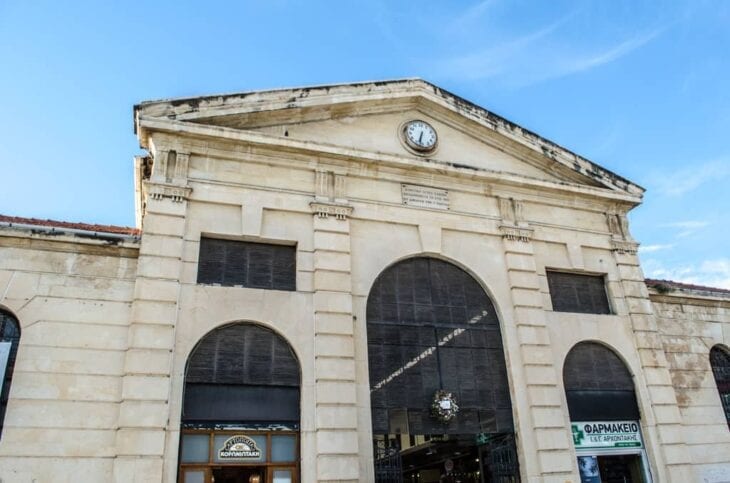
Chania Markets provides a variety of craft stalls in addition to its culinary offerings, showing traditional Cretan textiles, ceramics, clothes, and handmade ornaments. Vendors selling locally made olive oil, honey, wines, and spices allow tourists to take home a taste of the area’s gastronomic heritage as part of their deeper cultural immersion.
Last updated on January 13th, 2025














